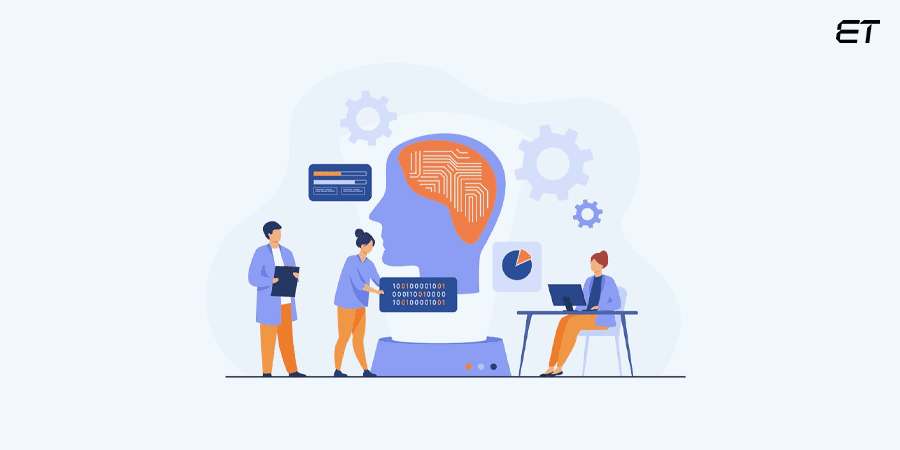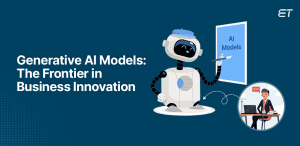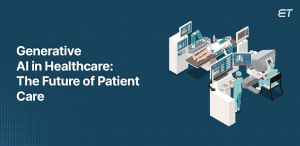‘AI is the new electricity.’ — Andrew Ng, Computer Scientist, Head of Google Brain, and co-founder.
Andrew’s quote on AI is quite bold and persuades you to think a lot about this research field. Such outlooks make it crucial to understand practical comparisons like ‘Generative AI vs Predictive AI.’
Get this — The USD 200+ billion AI market has two prominent sub-segments: generative and predictive. So, if you’re in the technology field, it’s crucial to receive accurate insights on this topic.
This blog on generative vs predictive AI aims to simplify these technologies. So, scroll ahead to read complex information in an easy-to-understand manner.
Generative AI vs Predictive AI: The Basics
Before moving on to the comparison section, it’ll be helpful to understand some fundamental terminologies.
So, without any ado, here are terms that you should know:
- Artificial intelligence (AI): A type of computer system or technology that can perform tasks demanding human-like intelligence
- Generative AI: A type of AI that can create content like text, videos, music, and images
- Predictive AI: Segment of AI that leverages data to forecast future events
The terms are pretty simple to understand, aren’t they?
Generative vs Predictive AI isn’t a difficult comparison to unravel. Both branches are quite distinct in their utilities. Once you comprehend some basic terms, differentiating the two types is straightforward.

Generative AI vs Predictive AI: The Direct Comparison
Examples of any technology make it easier to understand the terms. So, before moving on to the technicalities, here are the popular names falling under the two AI types.
| Artificial Intelligence Type | Prominent Examples |
| Generative AI | ChatGPT, Gemini, DALL-E |
| Predictive AI | Amazon Demand Forecasting, AliveCor, GE Predix |
Now, let’s proceed with the point-wise breakdown of predictive vs generative AI.
1. Prime Focus
This point refers to the primary intention of both AI subsets. Consider the following pointers in this comparison:
- Generative AI: This AI type focuses on ‘creation.’ It aims to develop new, relevant, and realistic content
- Predictive AI: ‘Forecast’ is the pivotal focus of this AI segment. It seeks to utilize data to predict future events or trends
With generative AI, you can develop new product designs as well. On the contrary, predictive AI scans historical data and patterns to make informed predictions.
2. Processing Approach
Generative AI focuses on analyzing existing content to suggest new and relevant output. You can imagine this subset similar to an artist, without emotions, of course!
On the other hand, predictive AI is like a detective or researcher. It scans massive amounts of datasets and looks for apt correlations. This analysis leads to an estimation of future occurrences.
Since the utility of both these AI types is distinct, you can’t pick a clear winner in the generative AI vs predictive AI comparison.
3. The Final Outcomes
Let’s continue our generative AI vs predictive AI comparison with a simple differentiation point—the end output.
Here are the simple points to consider:
- Generative AI: New and creative content
- Predictive AI: Potential estimates
In addition to text, generative AI models can generate visual content that is believable to the human audience. For instance, you can use this technology to generate images as per demand.
Predictive AI increases the chances of accurate estimates due to the scanning of large datasets. However, it doesn’t guarantee perfect suggestions. That’s why it’s predictive, right?


Want to make the best utilization of AI? Contact our experts to convey your requirements today!
4. Utility and Applications
This final point in the generative AI vs predictive AI comparison focuses on the segments’ usage. In other words, it addresses the question, ‘which domains should you use generative/predictive AI?’
Here’s a simple explanation:
- Generative AI: Art, content, IT, design, digital marketing, media, and entertainment
- Predictive AI: Business, finance, banking, e-commerce, retail and manufacturing
Overall, if you want to indulge in creative work, choose generative AI. On the other hand, if you’re formal and performing analytical tasks, go with predictive AI.
Comparing Generative with Predictive AI: A Quick Reference Table
In this section, we’ve organized the comparison points in a simple tabular format. Refer to the following content for a quick generative AI vs predictive AI overview.
| Feature | Generative AI | Predictive AI |
| Prime Focus | Creates new, relevant content | Predicts future events or trends |
| Processing Approach | Analyzes existing content to suggest new outputs | Analyzes data to identify patterns and correlations |
| Final Outcomes | New and creative content (text, images, etc.) | Potential estimates (predictions, not guarantees) |
| Utility and Applications | Art, content creation, design, marketing, media, entertainment | Business, finance, e-commerce, retail, manufacturing |



We have dedicated developers who can choose the best AI subset for your business. Contact us today to integrate AI into your high-tech web product.
Generative AI vs Predictive AI: Advantages and Challenges
Since the use case of both AI subsets is different, you cannot choose a clear winner. So, it’s logical to view the pros and cons distinctly.
The following tables mention these vital details for your perusal.
| Generative AI | |
| Advantages | Challenges |
| Automation of content development | Inability to leverage genuine creativity |
| Quick generation of ideas | Lack of minute understanding |
| Enhancement in creativity | High reliance on training data |
| Improvement in decision-making | Increase in computational demands |
Now, let’s move on to understanding the positives and challenges of predictive AI.
| Predictive AI | |
| Advantages | Challenges |
| Supply of data-driven insights | Heavy reliance on data accuracy |
| Appropriate technology for risk management | Limited accuracy and scope, requiring cross-verification |
| Suitable guide for resource optimization | Further need for human judgment |
| A potential tool for increasing revenue | Prone to algorithmic bias |
In a Nutshell: Predictive AI vs Generative AI
If you observe carefully, the generative AI vs predictive AI isn’t a conventional comparison. These subsets of artificial technology are entirely different in terms of their utility, focus, and approach.
In the case of generative AI, the relevant platform utilizes data to create content that suits your needs. Predictive AI is more advantageous for research and businesses in forecasting future events. Notably, it uses historical data to make predictions that can guide you in some sound decisions.
If you’re a business, you can leverage both generative and predictive AI. In fact, skilled software programmers can offer services to integrate such technologies into your website, app, or portal.
So, to best utilize generative or predictive AI, ensure you choose well-established AI software development services.
Frequently Asked Questions: Predictive AI vs Generative AI
1. Can we use generative AI for prediction?
Generative AI can support prediction tasks indirectly. It can create synthetic data and improve the training of predictive models. So, you can’t replace predictive AI with it, but it’s possible to leverage generative AI as a supplementary tool.
2. Is explainable AI similar to generative AI?
No. Explainable AI (XAI) helps us comprehend how specific AI models arrive at a particular conclusion. It focuses on transparency and can be a good guide for making vital decisions.
3. How can we address bias in generative AI and predictive AI?
We can implement tactics like utilizing diverse training data, monitoring AI models continually, and establishing ethical guidelines for the end deployment. Addressing bias is a continuous process, and it’s vital to keep evolving to maximize AI’s effectiveness.
4. How do you think generative AI and predictive AI will evolve in the future?
Artificial intelligence, both generative and predictive, can enhance creativity and allow you to leverage data at a brisk pace. You can integrate these subsets to facilitate real-time decision-making and perform relevant actions. However, using AI responsibly and ethically is essential to prevent misuse and protect user privacy.
Excellence-driven professional with 15+ years of experience in increasing productivity, and revenue, while effectively managing products of all sizes. He has worked for international clients in the US, UK, and Singapore and local companies in various domains. With excellent attention to detail and a methodical approach to execution, he is an expert in bringing projects to a successful stage. He follows James Humes’s famous saying- “The art of communication is the language of leadership.”







